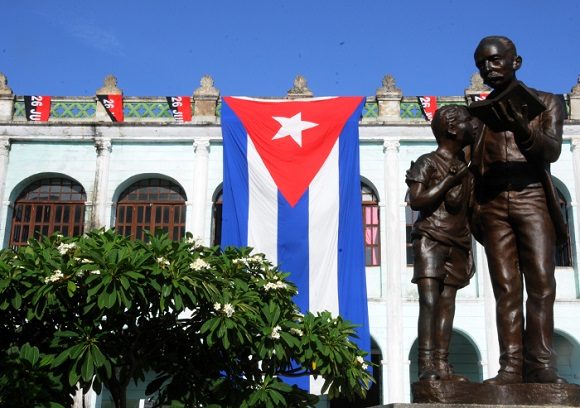
Camagüey, May 19th. - Impossible to forget, on a day like today, May 19, anniversary 130 of the fall in combat of José Martí, in Dos Ríos, the attachment he had for Camagüey, when I never even visit him, but he did show an approach with many of the sons of the former Puerto Príncipe.
Scholars of his work point out that the project as guardian of the Homeland focused on three basic ideas: morality, justice and freedom so that it would always endure under moral principles and values.
Martí conceived of coming to the Camaguey in March 1895 but because of other emergencies, it was impossible, although he managed to know that the youth would rise in their support with Salvador Cisneros at the head of the insurrection.
Many acts of his life, cut in Dos Ríos on May 19, 1895, approach José Martí with Camaguey. His chronicles, dedicated to Guáimaro, to the first constituent assembly of the Republic in Arms and the links with 119 historical figures of this beautiful eastern central region he portrayed, as he knew how to do with his brilliant pen.
It is reasonable that two main reasons linked him to this part of the narrow and elongated island, first of all, the marriage to Carmen Zayas-Bazán and Hidalgo and her return to Camaguey with her son, José Francisco, El Ismaelillo, after the breakup with her spouse.
Several years ago, under the scorching sun of that afternoon he arrived in Camaguey, Eusebio Leal Spengler, historian of Havana, with the purpose of the official inauguration of the rehabilitation of the youth square José Martí, in the historic center of the old city, with a segment declared by UNESCO as a World Cultural Heritage Site, with the brightness of the new sculpture of the local artist Roberto Estrada, a man also passionate about the Martian work.
On that occasion Leal said: Today we came to place this work made by an artist from the village to whom Martí never reached, but who loved... We come here at his altar where he is teaching a child, I remember his verses: Son, frightened of all I take refuge in you...
Leal said on that occasion, that Martí, who lived with the firm will of the apostles, knew how to rise up on the flaws and make himself heard of the poor with faith...who faced everything for unity.We come to pay tribute to him despite the sun. No matter what a few hours have passed on January 28, we come to place this work...
The sculpture, located in front of the central polyclinic, has a height of 1.80 meters and a weight of approximately 450 kilograms, adjusted to place, according to the characteristics of the buildings that surround it, was melted, for the first time, in marble and alabaster powder in the Caribbean handicraft factory in Havana and then molded in bronze at the Caguayo Foundation, in Santiago de Cuba.
The special symbol of this work is that it is nestled less than 100 meters from where José Francisco Martí Zayas Bazán lived during his childhood and adolescence with his mother, a house nestled on the current street Luaces 109, between República and San Pablo, although he does not yet have a tarja that distinguishes that historical detail.
Today in which we pay tribute to the most universal of Cubans, whom Fidel Castro Ruz, whom I call with the intellectual author of the Assault on the Moncade Headquarters, illustrates as closing this article what the prophet said about death.
"Death is not true when the work of life has been well fulfilled; the thinking skull has been dusted; but they live perpetually and fruitful the thoughts that were elaborated in it." (Enrique Atiénzar Rivero/Collaborator of Radio Cadena Agramonte) (Photo: Taken from Adelante Digital)